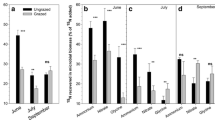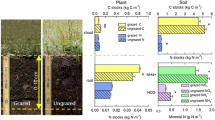Abstract
Plant-microbe interactions are crucial regulators of belowground nitrogen cycling in terrestrial ecosystems. However, such interactions have mostly been excluded from experimental setups for the investigation of gross inorganic N fluxes and N partitioning to plants and microorganisms. Ungulate grazing is likely to feed back on soil N fluxes, and hence it is of special importance to simultaneously investigate grazing effects on both plant and microbial N fluxes in intact plant-soil systems, where plant-microbe interactions persist during the experimental incubation. Based on the homogenous 15NH +4 labelling of intact plant-soil monoliths we investigated how various stocking rates (0, 2.35, 4.8 and 7.85 sheep ha−1 grazing season−1) in steppe of Inner Mongolia feedback on gross rates of N mineralization and short-term inorganic N partitioning between plant, microbial and soil N pools. Our results showed that the effect of grazing on gross N mineralization was non-uniform. At low stocking rate gross N mineralization tended to decrease but increased with higher grazing pressure. Hence, there was no significant correlation between stocking rate and gross N mineralization across the investigated grazing intensities. Grazing decreased 15N recovery both in plant and microbial N pools but strongly promoted NO −3 accumulation in the soil and thus negatively affected potential ecosystem N retention. This appeared to be closely related to the grazing-induced decline in easily degradable soil C availability at increasing stocking rate.


Similar content being viewed by others

References
Accoe F, Boeckx P, Busschaert J, Hofman G, VanCleemput O (2004) Gross N transformation rates and net N mineralization rates related to the C and N contents of soil organic matter fractions in grassland soils of different age. Soil Biol Biochem 36:2075–2087
Accoe F, Boeckx P, Videla X, Pino I, Hofman G, VanCleemput O (2005) Estimation of gross nitrogen transformations and nitrogen retention in grassland soils using FLUAZ. Soil Sci Soc Am J 69:1967–1976
Arnold J, Corre MD, Veldkamp E (2008) Cold storage and laboratory incubation of intact soil cores do not reflect in-situ nitrogen cycling rates of tropical forest soils. Soil Biol Biochem 40:2480–2483
Bai YF, Han XG, Wu JG, Chen ZZ, Li LH (2004) Ecosystem stability and compensatory effects in the Inner Mongolia grassland. Nature 431:181–4
Bais HP, Weir TL, Perry LG, Gilroy S, Vivanco JM (2006) The role of root exudates in rhizosphere interations with plants and other organisms. Annu Rev Plant Biol 57:233–266
Bardgett RD, Wardle DA (2003) Herbivore-mediated linkages between aboveground and below-ground communities. Ecology 84:2258–2268
Biondini ME, Patton BD, Nyren PE (1998) Grazing intensity and ecosystem processes in a northern mixed-grass prairie, USA. Ecol Appl 8:469–479
Booth MS, Stark JM, Rastetter E (2005) Controls on nitrogen cycling in terrestrial ecosystems: a synthetic analysis of literature data. Ecol Monogr 75:139–157
Booth MS, Stark JM, Hart SC (2006) Soil-mixing effects on inorganic nitrogen production and consumption in forest and shrubland soils. Plant Soil 289:5–15
Brookes PC, Landman A, Pruden G, Jenkinson DS (1985) Chloroform fumigation and the release of soil nitrogen: a rapid direct extraction method for measuring microbial biomass nitrogen in soil. Soil Biol Biochem 17:837–842
Burger M, Jackson LE (2004) Plant and microbial nitrogen use and turnover: rapid conversion of nitrate to ammonium in soil with roots. Plant Soil 266:289–301
Cabrera ML, Beare MH (1993) Akaline persulfate oxidation for determining total nitrogen in microbial biomass extracts. Soil Sci Soc Am J 57:1007–1012
Chapman SK, Langley JA, Hart SC, Koch GW (2006) Plants actively control nitrogen cycling: uncorking the microbial bottleneck. New Phytol 169:27–34
Chapuis-Lardy L, Wrage N, Metay A, Chotte JL, Bernoux M (2007) Soils, a sink for N2O? A review. Glob Chang Biol 13:1–17
Chen J, Stark JM (2000) Plant species effects and carbon and nitrogen cycling in a sagebrush crested wheatgrass soil. Soil Biol Biochem 32:47–57
Corre MD, Schnabel RR, Stout WL (2002) Spatial and seasonal variation gross nitrogen transformations and microbial biomass in a Northeastern US grassland. Soil Biol Biochem 34:445–57
Corre MD, Brumme R, VEldkamp E, Beese F (2007) Changes in nitrogen cycling and retention processes in soils under spruce forests along a nitrogen enrichment gradient in Germany. Glob Chang Biol 13:1509–1527
Dannenmann M, Gasche R, Ledebuhr A, Papen H (2006) Effects of forest management on soil N cycling in beech forests stocking on calcareous soils. Plant Soil 287:279–300
Dannenmann M, Gasche R, Papen H (2007) Nitrogen turnover and N2O production in the forest floor of beech stands as influenced by forest management. J Plant Nutr Soil Sci 170:134–144
Dannenmann M, Simon J, Gasche R, Holst J, Pena R, Naumann PS, Kögel-Knabner I, Knicker H, Mayer H, Schloter M, Polle A, Rennenberg H, Papen H (2009) Tree girdling provides insight on the role of labile carbon in nitrogen partitioning between soil microorganisms and adult European beech. Soil Biol Biochem 41:1622–1631
Davidson EA, Hart SC, Shanks CA, Firestone MK (1991) Measuring gross nitrogen mineralization, immobilization, and nitrification by 15N isotopic pool dilution in intact soil cores. J Soil Sci 42:335–349
Davidson EA, Chorover J, Dail DB (2003) A mechanism of abiotic immobilization of nitrate in forest ecosystems: the ferrous wheel hypothesis. Glob Chang Biol 9:228–236
Frank DA, Groffman PM, David Evans R, Tracy BF (2000) Ungulates stimulation of nitrogen cycling and retention in Yellowstone Park grasslands. Oecologia 123:116–121
Geßler A, Jung K, Gasche R, Papen H, Heidenfelder A, Börner E, Metzler B, Augustin S, Hildebrand E, Rennenberg H (2005) Climate and forest management influence nitrogen balance of European beech forests: microbial N transformations and inorganic N net uptake capacity of mycorrhizal roots. Eur J For Res 124:95–111
Graetz D (1994) Grasslands. In: Meyer W, Turner B (eds) Change in land use and land cover, a global perspective. Cambridge University Press, Cambridge, pp 287–328
Groffman PM, Rice CW, Tiedje JM (1993) Denitrification in a tallgrass prairie landscape. Ecology 74:855–862
Hamilton EW, Frank DA (2001) Can plants stimulate soil microbes and their own nutrient supply? Evidence from a grazing tolerant grass. Ecology 82:2397–2402
Harrison KA, Bol R, Bardgett RD (2007) Preferences for different nitrogen forms by coexisting plant species and soil microbes. Ecology 88:989–999
Harrison KA, Bol R, Bardgett RD (2008) Do plant species with different growth strategies vary in their ability to compete with soil microbes for chemical forms of nitrogen? Soil Biol Biochem 40:228–237
Hodge A, Robinson D, Fitter A (2000) Are microorganisms more effective than plants at competing for nitrogen? Trends Plant Sci 5:304–308
Högberg P, Read DJ (2006) Towards a more plant physiological perspective on soil ecology. Trends Ecol Evol 21:548–554
Holland JN, Cheng WX, Crossley DA (1996) Herbivore-induced changes in plant carbon allocation: assessment of belowground C fluxes using carbon-14. Oecologia 107:87–94
Holst J, Liu CY, Brüggemann N, Butterbach-Bahl K, Zheng XH, Wang YS, Han SH, Yao ZS, Han XG (2007) Microbial N turnover and N-Oxide (N2O/NO/NO2) fluxes in semi-arid grassland of inner Mongolia. Ecosystems 10:623–634
Jones DL, Edwards AC, Donachie K, Darrah PR (1994) Role of proteinaceous amino-acids released in root exudates in nutrient acquisition from the rhizosphere. Plant Soil 158:183–192
Kirkham D, Bartholomew WV (1954) Equations for following nutrient transformations in soil utilizing tracer data. Soil Sci Soc Am Proc 18:33–34
Kuzyakov Y, Domanski G (2000) Carbon input by plants into the soil. J Plant Nutr Soil Sci 163:421–431
Le Roux X, Bardy M, Loiseau P, Louault F (2003) Stimulation of soil nitrification and denitrification by grazing in grasslands: do changes in plant species composition matter? Oecologia 137:417–425
Li SG, Harazono Y, Oikawa T, Zhao HL, He ZY, Chang XL (2000) Grassland desertification by grazing and the resulting micrometeorological changes in Inner Mongolia. Agric For Meteorol 102:125–137
Murphy DV, Recous S, Stockdale EA, Fillery IRP, Jensen LS, Hatch DJ, Goulding KWT (2003) Gross nitrogen fluxes in soil: theory, measurement and application of N-15 pool dilution techniques. Adv Agron 79:69–118
Olofsson J, Kitti H, Rautiainen P, Stark S, Oksanen L (2001) Effects of summer grazing by reindeer on composition of vegetation, productivity and nitrogen cycling. Ecography 24:13–24
Rennenberg H, Dannenmann M, Gessler A, Kreuzwieser J, Simon J, Papen H (2009) Nitrogen balance in forest soils: nutritional limitation of plants under climate change stresses. Plant Biol 11:4–23
Rosenkranz P, Dannenmann M, Brüggemann N, Papen H, Berger U, Zumbusch E, Butterbach-Bahl K (2010) Gross ammonification and nitrification at a nitrogen-saturated spruce (Picea abies (L.) Karst.) stand in Southern Germany. Eur J Soil Sci in press
Schimel JP, Bennett J (2004) Nitrogen mineralization: challenges of a changing paradigm. Ecology 85:591–602
Schoenbach P, Wan H, Schiborra A (2009) Short-term management and stocking rate effects of grazing sheep on herbage quality and productivity of Inner Mongolia steppe. Crop Pasture Sci 60:963–974
Stark JM (2000) Nutrient transformations. In: Sala OE, Jackson RB, Mooney HA, Howarth RW (eds) Methods in ecosystem science. Springer, New York
Steffens M, Kölbl A, Totsche KU, Kögel-Knabner I (2008) Grazing effects on soil chemical and physical properties in a semiarid steppe of Inner Mongolia (P.R. China). Geoderma 143:63–72
Steffens M, Kolbl A, Koegel-Knabner I (2009) Alteration of soil organic matter pools and aggregation in semi-arid steppe topsoils as driven by organic matter input. Eur J Soil Sci 60:198–212
Tracy BF, Frank DA (1998) Herbivore influence on soil microbial biomass and nitrogen mineralization in a northern grassland ecosystem: Yellowstone National Park. Oecologia 114:556–562
van der Heijden MGA, Bardgett RD, van Straalen NM (2008) The unseen majority: soil microbes as drivers of plant diversity and productivity in terrestrial ecosystems. Ecol Lett 11:296–310
van Wijnen HJ, van der Wal R, Bakker JP (1999) The impact of herbivores on nitrogen mineralization rate: consequences for salt–marsh succession. Oecologia 118:225–231
Vance ED, Brookes PC, Jenkinson DS (1987) An extraction method for measuring soil microbial biomass C. Soil Biol Biochem 19:703–707
Verchot LV, Groffman PM, Frank DA (2002) Landscape versus ungulate control of gross mineralization and gross nitrification in semi-arid grasslands of Yellowstone National Park. Soil Biol Biochem 34:1691–9
Wiesmeier M, Steffens M, Kolbl A, Koegel-Knabner I (2009) Degradation and small-scale spatial homogenization of topsoils in intensively-grazed steppes of Northern China. Soil Tillage Res 104:299–310
Wolf B, Zheng X, Brüggemann N, Chen W, Dannenmann M, Han X, Sutton MA, Wu H, Yao Z, Butterbach-Bahl K (2010) Grazing-induced reduction of natural nitrous oxide release from continental steppe. Nature 464:881–884
Xu YQ, Li LH, Wang QB, Chen QS, Cheng WX (2007) The pattern between nitrogen mineralization and grazing intensities in an Inner Mongolian typical steppe. Plant Soil 300:289–300
Xu XL, Stange CF, Richter A, Wanek W, Kuzyakov Y (2008) Light affects competition for inorganic and organic nitrogen between maize and rhizosphere microorganisms. Plant Soil 304:59–72
Zacheis A, Ruess RW, Hupp JW (2002) Nitrogen dynamics in an Alaskan salt marsh following spring use by geese. Oecologia 130:600–608
Acknowledgements
Funding of this work by the German Research Foundation/Deutsche Forschungsgemeinschaft (DFG) within the framework of the MAGIM research group and the joint laboratory of IMK-IFU and IAP-CAS as funded by the Helmholtz Society is gratefully acknowledged. We thank Katrin Müller, Philipp Schönbach, Hongwei Wan and Li-Jin Lin for maintaining the grazing experiment. Furthermore we wish to thank Rudi Meyer, Bärbel Biegler and Yuandi Zhu for technical support and Shenghui Han for logistic support
Author information
Authors and Affiliations
Corresponding author
Additional information
Responsible Editor: Ingrid Koegel-Knabner.
Rights and permissions
About this article
Cite this article
Wu, H., Dannenmann, M., Fanselow, N. et al. Feedback of grazing on gross rates of N mineralization and inorganic N partitioning in steppe soils of Inner Mongolia. Plant Soil 340, 127–139 (2011). https://doi.org/10.1007/s11104-010-0575-z
Received:
Accepted:
Published:
Issue Date:
DOI: https://doi.org/10.1007/s11104-010-0575-z



